Strategic Change Models and Frameworks for Organizational Management
VerifiedAdded on 2022/05/25
|11
|3294
|38
Report
AI Summary
This report, written for a Managing Change module, analyzes factors driving strategic change within organizations, particularly in response to market shifts like the transition from print to digital media in the bookselling industry. It evaluates several strategic change models, including John Kotter's eight-stage model, the McKinsey 7-S framework, and the ADKAR model, assessing their benefits for organizations undergoing change. The report also examines how Amazon has utilized these models to support its strategic shifts, such as expanding from books to a broader range of products. The analysis emphasizes the importance of people in the change management process, the need to adapt to consumer preferences, and the advantages of using models to anticipate challenges, align resources, and improve organizational performance. The report concludes by highlighting the benefits of these models in managing change and ensuring a smoother transition for employees.
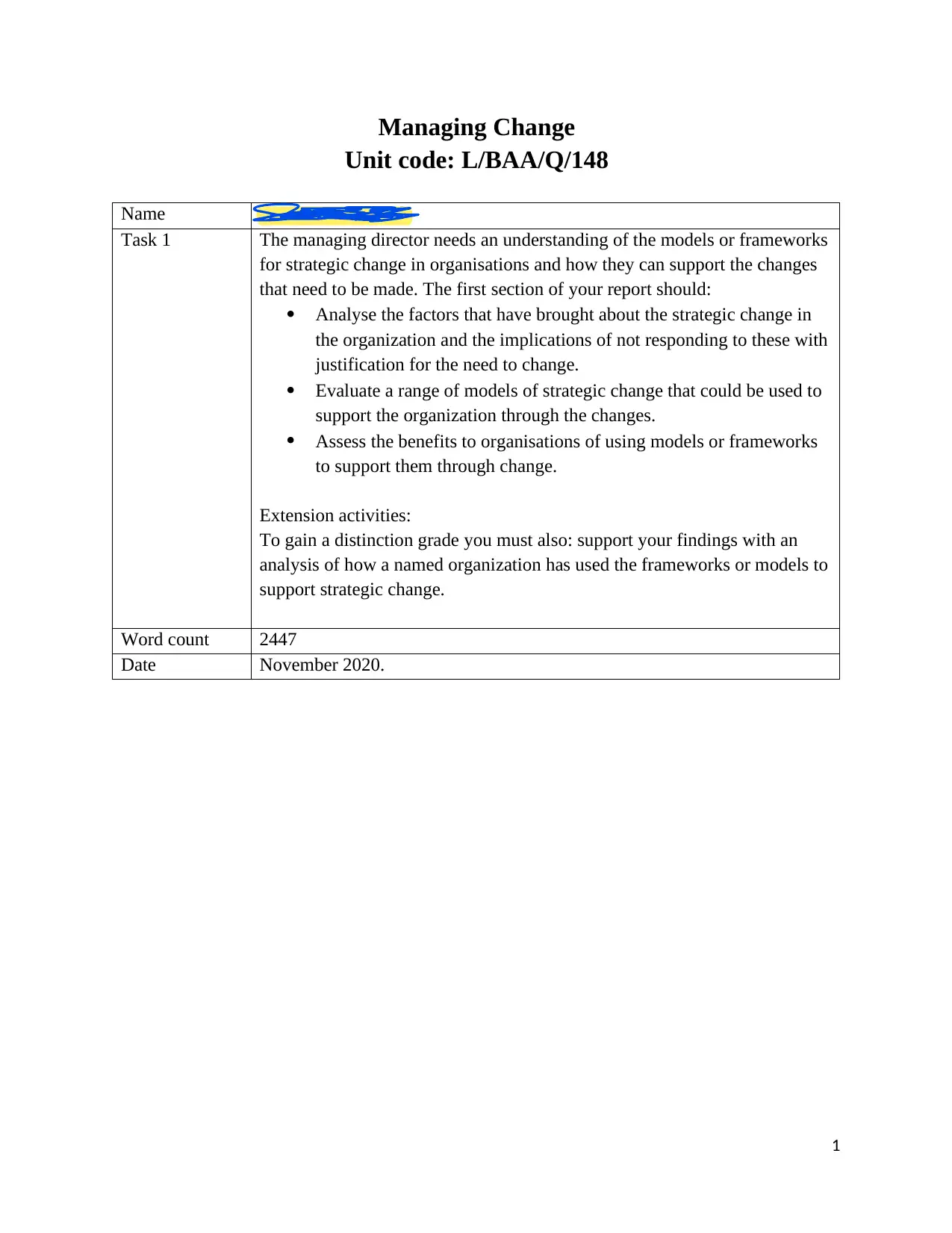
1
Managing Change
Unit code: L/BAA/Q/148
Name Yanique Townsend
Task 1 The managing director needs an understanding of the models or frameworks
for strategic change in organisations and how they can support the changes
that need to be made. The first section of your report should:
Analyse the factors that have brought about the strategic change in
the organization and the implications of not responding to these with
justification for the need to change.
Evaluate a range of models of strategic change that could be used to
support the organization through the changes.
Assess the benefits to organisations of using models or frameworks
to support them through change.
Extension activities:
To gain a distinction grade you must also: support your findings with an
analysis of how a named organization has used the frameworks or models to
support strategic change.
Word count 2447
Date November 2020.
Managing Change
Unit code: L/BAA/Q/148
Name Yanique Townsend
Task 1 The managing director needs an understanding of the models or frameworks
for strategic change in organisations and how they can support the changes
that need to be made. The first section of your report should:
Analyse the factors that have brought about the strategic change in
the organization and the implications of not responding to these with
justification for the need to change.
Evaluate a range of models of strategic change that could be used to
support the organization through the changes.
Assess the benefits to organisations of using models or frameworks
to support them through change.
Extension activities:
To gain a distinction grade you must also: support your findings with an
analysis of how a named organization has used the frameworks or models to
support strategic change.
Word count 2447
Date November 2020.
Paraphrase This Document
Need a fresh take? Get an instant paraphrase of this document with our AI Paraphraser
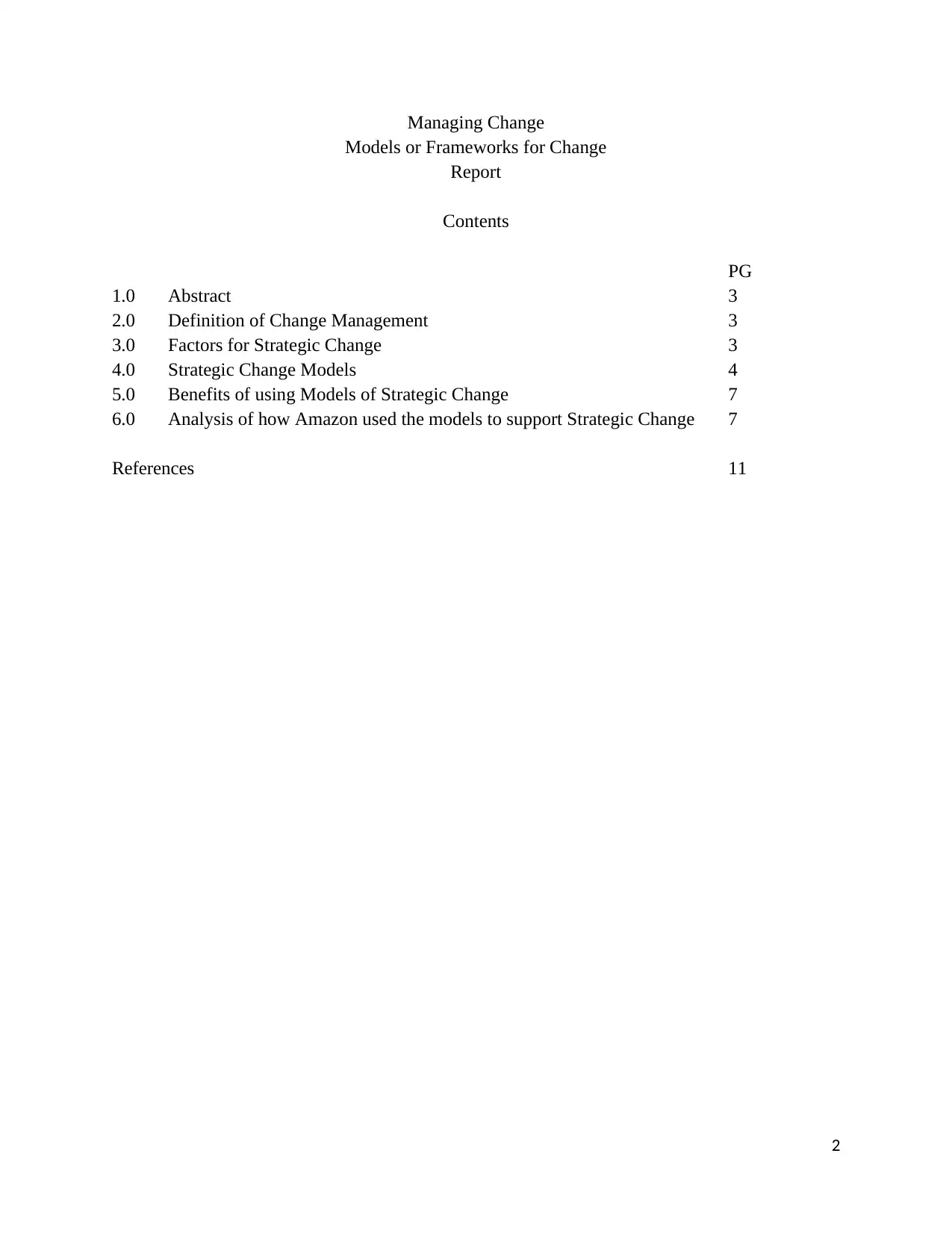
2
Managing Change
Models or Frameworks for Change
Report
Contents
PG
1.0 Abstract 3
2.0 Definition of Change Management 3
3.0 Factors for Strategic Change 3
4.0 Strategic Change Models 4
5.0 Benefits of using Models of Strategic Change 7
6.0 Analysis of how Amazon used the models to support Strategic Change 7
References 11
Managing Change
Models or Frameworks for Change
Report
Contents
PG
1.0 Abstract 3
2.0 Definition of Change Management 3
3.0 Factors for Strategic Change 3
4.0 Strategic Change Models 4
5.0 Benefits of using Models of Strategic Change 7
6.0 Analysis of how Amazon used the models to support Strategic Change 7
References 11
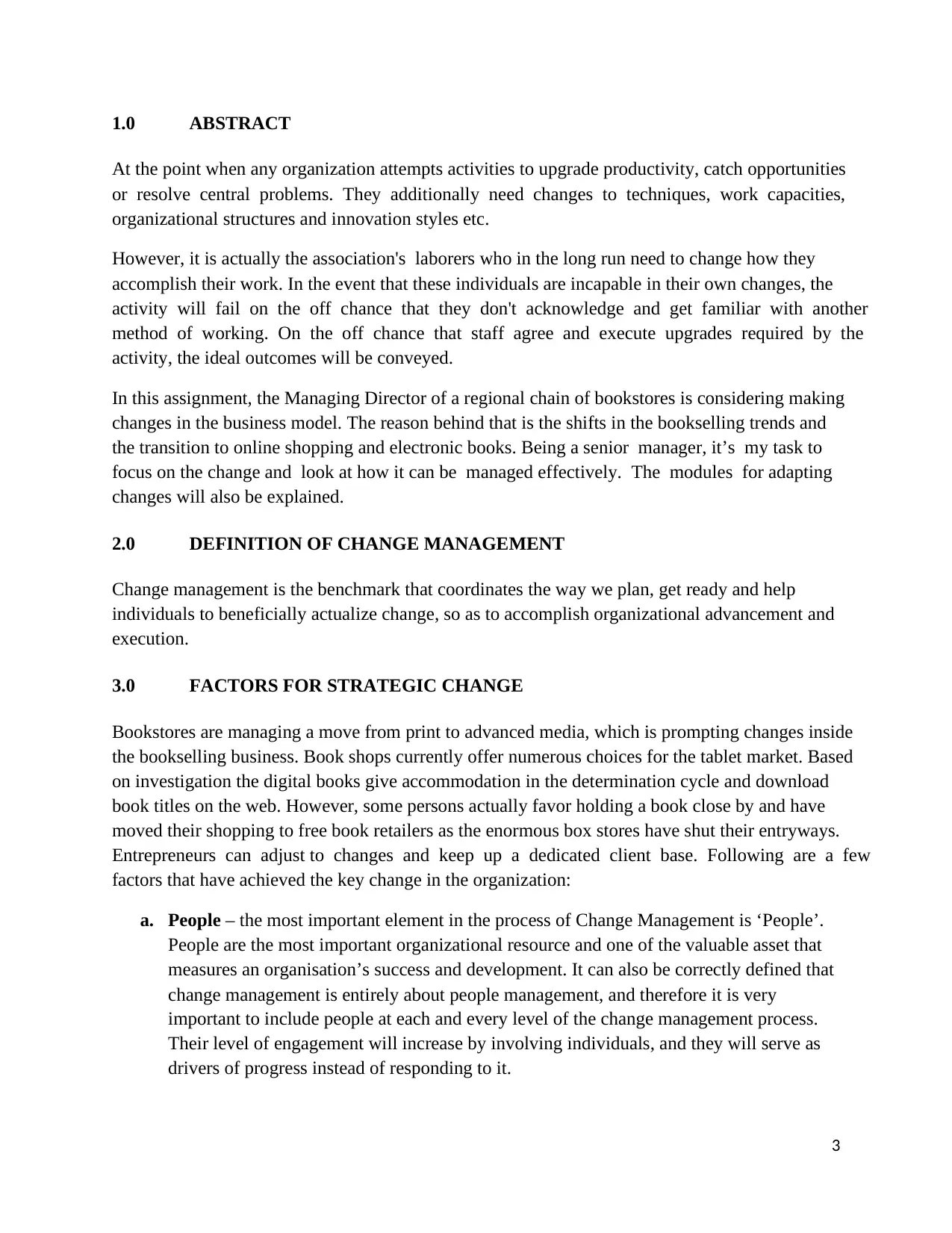
3
1.0 ABSTRACT
At the point when any organization attempts activities to upgrade productivity, catch opportunities
or resolve central problems. They additionally need changes to techniques, work capacities,
organizational structures and innovation styles etc.
However, it is actually the association's laborers who in the long run need to change how they
accomplish their work. In the event that these individuals are incapable in their own changes, the
activity will fail on the off chance that they don't acknowledge and get familiar with another
method of working. On the off chance that staff agree and execute upgrades required by the
activity, the ideal outcomes will be conveyed.
In this assignment, the Managing Director of a regional chain of bookstores is considering making
changes in the business model. The reason behind that is the shifts in the bookselling trends and
the transition to online shopping and electronic books. Being a senior manager, it’s my task to
focus on the change and look at how it can be managed effectively. The modules for adapting
changes will also be explained.
2.0 DEFINITION OF CHANGE MANAGEMENT
Change management is the benchmark that coordinates the way we plan, get ready and help
individuals to beneficially actualize change, so as to accomplish organizational advancement and
execution.
3.0 FACTORS FOR STRATEGIC CHANGE
Bookstores are managing a move from print to advanced media, which is prompting changes inside
the bookselling business. Book shops currently offer numerous choices for the tablet market. Based
on investigation the digital books give accommodation in the determination cycle and download
book titles on the web. However, some persons actually favor holding a book close by and have
moved their shopping to free book retailers as the enormous box stores have shut their entryways.
Entrepreneurs can adjust to changes and keep up a dedicated client base. Following are a few
factors that have achieved the key change in the organization:
a. People – the most important element in the process of Change Management is ‘People’.
People are the most important organizational resource and one of the valuable asset that
measures an organisation’s success and development. It can also be correctly defined that
change management is entirely about people management, and therefore it is very
important to include people at each and every level of the change management process.
Their level of engagement will increase by involving individuals, and they will serve as
drivers of progress instead of responding to it.
1.0 ABSTRACT
At the point when any organization attempts activities to upgrade productivity, catch opportunities
or resolve central problems. They additionally need changes to techniques, work capacities,
organizational structures and innovation styles etc.
However, it is actually the association's laborers who in the long run need to change how they
accomplish their work. In the event that these individuals are incapable in their own changes, the
activity will fail on the off chance that they don't acknowledge and get familiar with another
method of working. On the off chance that staff agree and execute upgrades required by the
activity, the ideal outcomes will be conveyed.
In this assignment, the Managing Director of a regional chain of bookstores is considering making
changes in the business model. The reason behind that is the shifts in the bookselling trends and
the transition to online shopping and electronic books. Being a senior manager, it’s my task to
focus on the change and look at how it can be managed effectively. The modules for adapting
changes will also be explained.
2.0 DEFINITION OF CHANGE MANAGEMENT
Change management is the benchmark that coordinates the way we plan, get ready and help
individuals to beneficially actualize change, so as to accomplish organizational advancement and
execution.
3.0 FACTORS FOR STRATEGIC CHANGE
Bookstores are managing a move from print to advanced media, which is prompting changes inside
the bookselling business. Book shops currently offer numerous choices for the tablet market. Based
on investigation the digital books give accommodation in the determination cycle and download
book titles on the web. However, some persons actually favor holding a book close by and have
moved their shopping to free book retailers as the enormous box stores have shut their entryways.
Entrepreneurs can adjust to changes and keep up a dedicated client base. Following are a few
factors that have achieved the key change in the organization:
a. People – the most important element in the process of Change Management is ‘People’.
People are the most important organizational resource and one of the valuable asset that
measures an organisation’s success and development. It can also be correctly defined that
change management is entirely about people management, and therefore it is very
important to include people at each and every level of the change management process.
Their level of engagement will increase by involving individuals, and they will serve as
drivers of progress instead of responding to it.
⊘ This is a preview!⊘
Do you want full access?
Subscribe today to unlock all pages.

Trusted by 1+ million students worldwide
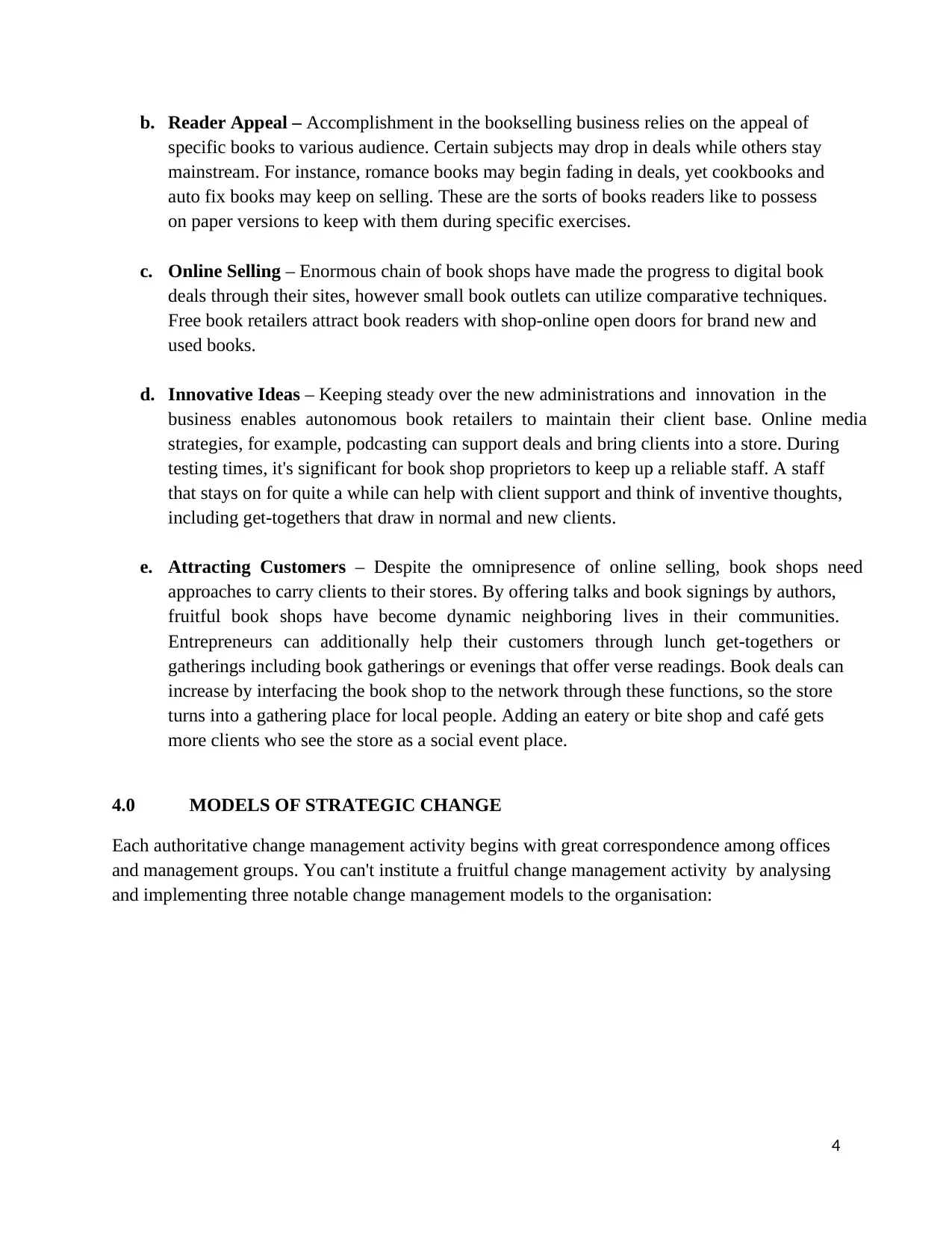
4
b. Reader Appeal – Accomplishment in the bookselling business relies on the appeal of
specific books to various audience. Certain subjects may drop in deals while others stay
mainstream. For instance, romance books may begin fading in deals, yet cookbooks and
auto fix books may keep on selling. These are the sorts of books readers like to possess
on paper versions to keep with them during specific exercises.
c. Online Selling – Enormous chain of book shops have made the progress to digital book
deals through their sites, however small book outlets can utilize comparative techniques.
Free book retailers attract book readers with shop-online open doors for brand new and
used books.
d. Innovative Ideas – Keeping steady over the new administrations and innovation in the
business enables autonomous book retailers to maintain their client base. Online media
strategies, for example, podcasting can support deals and bring clients into a store. During
testing times, it's significant for book shop proprietors to keep up a reliable staff. A staff
that stays on for quite a while can help with client support and think of inventive thoughts,
including get-togethers that draw in normal and new clients.
e. Attracting Customers – Despite the omnipresence of online selling, book shops need
approaches to carry clients to their stores. By offering talks and book signings by authors,
fruitful book shops have become dynamic neighboring lives in their communities.
Entrepreneurs can additionally help their customers through lunch get-togethers or
gatherings including book gatherings or evenings that offer verse readings. Book deals can
increase by interfacing the book shop to the network through these functions, so the store
turns into a gathering place for local people. Adding an eatery or bite shop and café gets
more clients who see the store as a social event place.
4.0 MODELS OF STRATEGIC CHANGE
Each authoritative change management activity begins with great correspondence among offices
and management groups. You can't institute a fruitful change management activity by analysing
and implementing three notable change management models to the organisation:
b. Reader Appeal – Accomplishment in the bookselling business relies on the appeal of
specific books to various audience. Certain subjects may drop in deals while others stay
mainstream. For instance, romance books may begin fading in deals, yet cookbooks and
auto fix books may keep on selling. These are the sorts of books readers like to possess
on paper versions to keep with them during specific exercises.
c. Online Selling – Enormous chain of book shops have made the progress to digital book
deals through their sites, however small book outlets can utilize comparative techniques.
Free book retailers attract book readers with shop-online open doors for brand new and
used books.
d. Innovative Ideas – Keeping steady over the new administrations and innovation in the
business enables autonomous book retailers to maintain their client base. Online media
strategies, for example, podcasting can support deals and bring clients into a store. During
testing times, it's significant for book shop proprietors to keep up a reliable staff. A staff
that stays on for quite a while can help with client support and think of inventive thoughts,
including get-togethers that draw in normal and new clients.
e. Attracting Customers – Despite the omnipresence of online selling, book shops need
approaches to carry clients to their stores. By offering talks and book signings by authors,
fruitful book shops have become dynamic neighboring lives in their communities.
Entrepreneurs can additionally help their customers through lunch get-togethers or
gatherings including book gatherings or evenings that offer verse readings. Book deals can
increase by interfacing the book shop to the network through these functions, so the store
turns into a gathering place for local people. Adding an eatery or bite shop and café gets
more clients who see the store as a social event place.
4.0 MODELS OF STRATEGIC CHANGE
Each authoritative change management activity begins with great correspondence among offices
and management groups. You can't institute a fruitful change management activity by analysing
and implementing three notable change management models to the organisation:
Paraphrase This Document
Need a fresh take? Get an instant paraphrase of this document with our AI Paraphraser
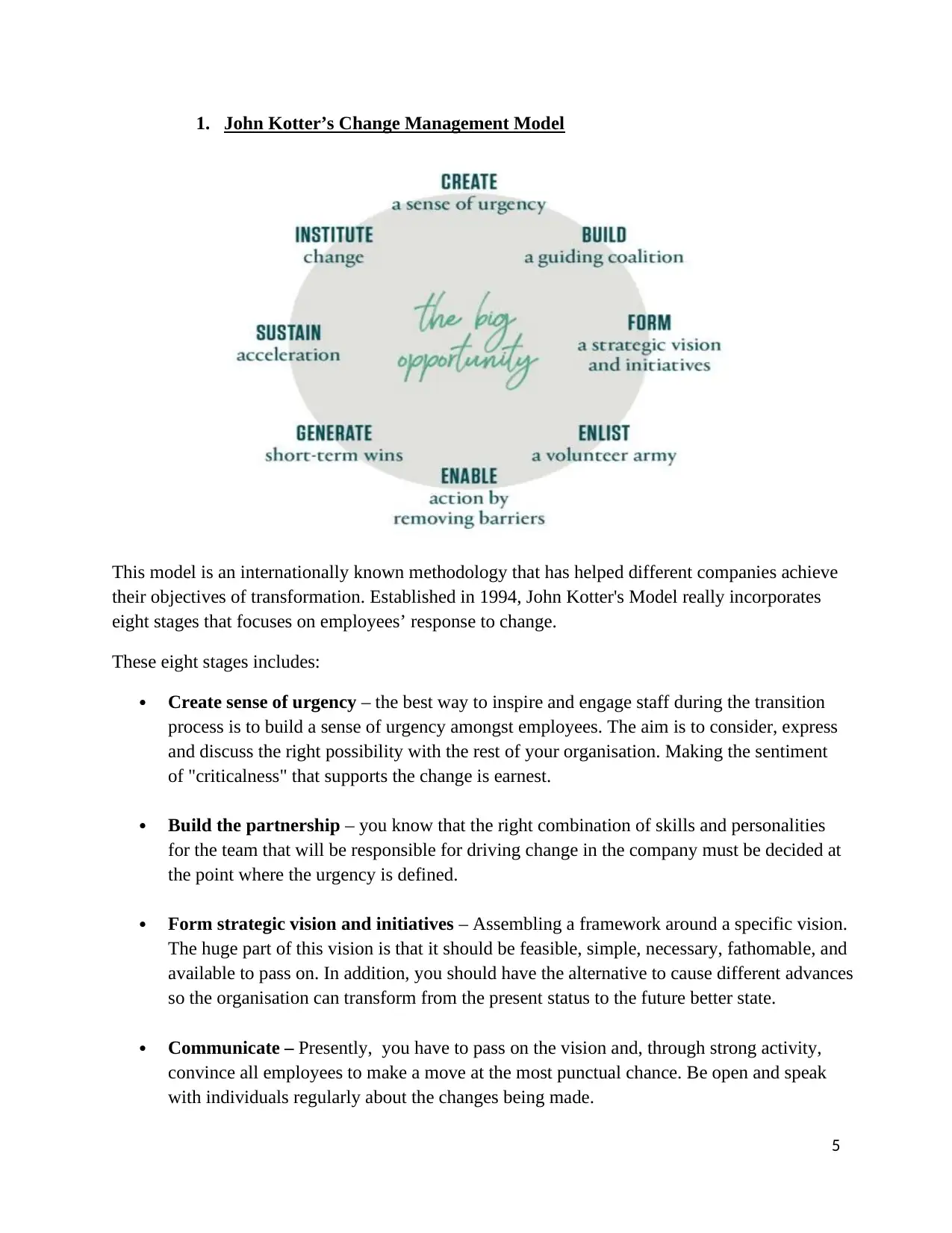
5
1. John Kotter’s Change Management Model
This model is an internationally known methodology that has helped different companies achieve
their objectives of transformation. Established in 1994, John Kotter's Model really incorporates
eight stages that focuses on employees’ response to change.
These eight stages includes:
Create sense of urgency – the best way to inspire and engage staff during the transition
process is to build a sense of urgency amongst employees. The aim is to consider, express
and discuss the right possibility with the rest of your organisation. Making the sentiment
of "criticalness" that supports the change is earnest.
Build the partnership – you know that the right combination of skills and personalities
for the team that will be responsible for driving change in the company must be decided at
the point where the urgency is defined.
Form strategic vision and initiatives – Assembling a framework around a specific vision.
The huge part of this vision is that it should be feasible, simple, necessary, fathomable, and
available to pass on. In addition, you should have the alternative to cause different advances
so the organisation can transform from the present status to the future better state.
Communicate – Presently, you have to pass on the vision and, through strong activity,
convince all employees to make a move at the most punctual chance. Be open and speak
with individuals regularly about the changes being made.
1. John Kotter’s Change Management Model
This model is an internationally known methodology that has helped different companies achieve
their objectives of transformation. Established in 1994, John Kotter's Model really incorporates
eight stages that focuses on employees’ response to change.
These eight stages includes:
Create sense of urgency – the best way to inspire and engage staff during the transition
process is to build a sense of urgency amongst employees. The aim is to consider, express
and discuss the right possibility with the rest of your organisation. Making the sentiment
of "criticalness" that supports the change is earnest.
Build the partnership – you know that the right combination of skills and personalities
for the team that will be responsible for driving change in the company must be decided at
the point where the urgency is defined.
Form strategic vision and initiatives – Assembling a framework around a specific vision.
The huge part of this vision is that it should be feasible, simple, necessary, fathomable, and
available to pass on. In addition, you should have the alternative to cause different advances
so the organisation can transform from the present status to the future better state.
Communicate – Presently, you have to pass on the vision and, through strong activity,
convince all employees to make a move at the most punctual chance. Be open and speak
with individuals regularly about the changes being made.
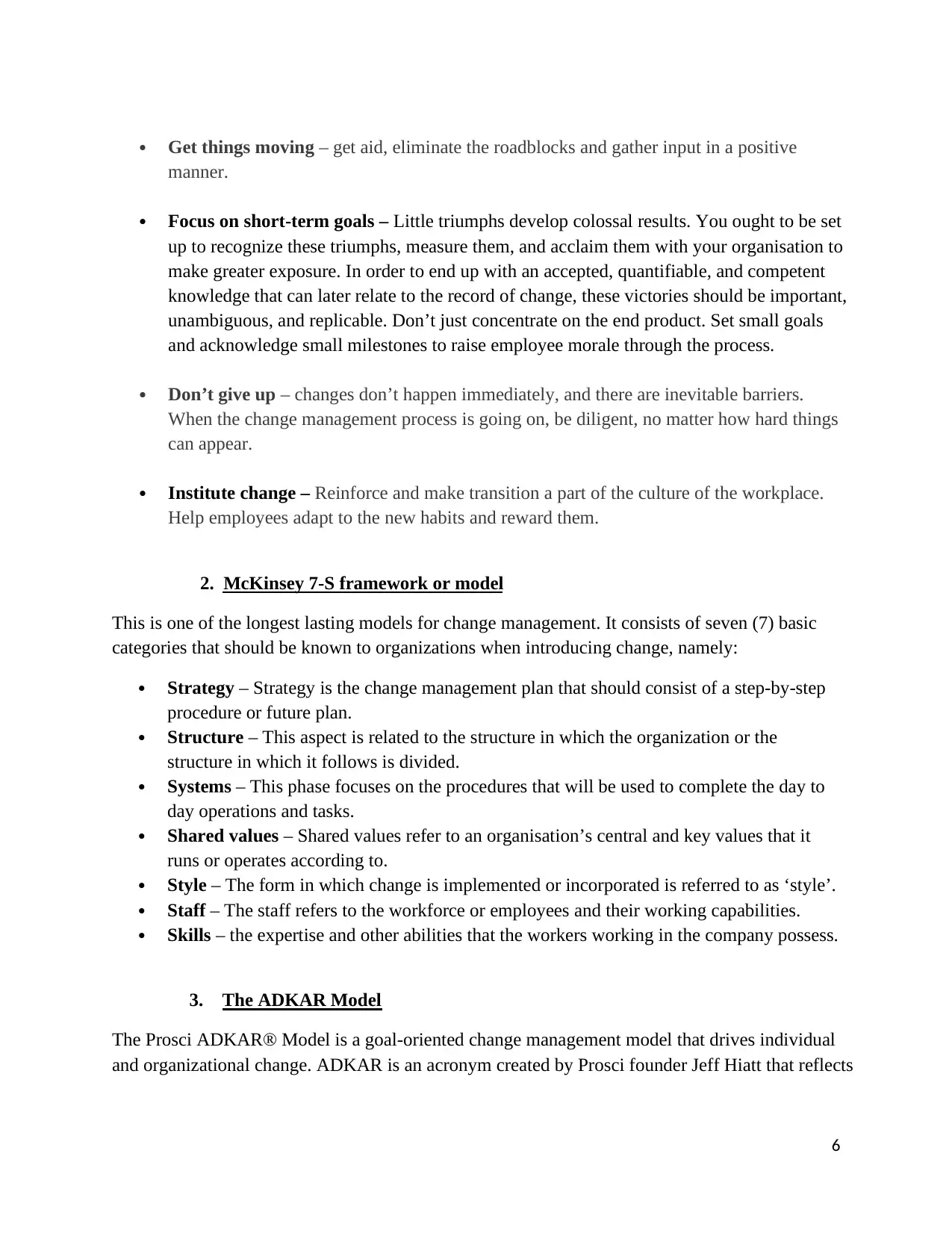
6
Get things moving – get aid, eliminate the roadblocks and gather input in a positive
manner.
Focus on short-term goals – Little triumphs develop colossal results. You ought to be set
up to recognize these triumphs, measure them, and acclaim them with your organisation to
make greater exposure. In order to end up with an accepted, quantifiable, and competent
knowledge that can later relate to the record of change, these victories should be important,
unambiguous, and replicable. Don’t just concentrate on the end product. Set small goals
and acknowledge small milestones to raise employee morale through the process.
Don’t give up – changes don’t happen immediately, and there are inevitable barriers.
When the change management process is going on, be diligent, no matter how hard things
can appear.
Institute change – Reinforce and make transition a part of the culture of the workplace.
Help employees adapt to the new habits and reward them.
2. McKinsey 7-S framework or model
This is one of the longest lasting models for change management. It consists of seven (7) basic
categories that should be known to organizations when introducing change, namely:
Strategy – Strategy is the change management plan that should consist of a step-by-step
procedure or future plan.
Structure – This aspect is related to the structure in which the organization or the
structure in which it follows is divided.
Systems – This phase focuses on the procedures that will be used to complete the day to
day operations and tasks.
Shared values – Shared values refer to an organisation’s central and key values that it
runs or operates according to.
Style – The form in which change is implemented or incorporated is referred to as ‘style’.
Staff – The staff refers to the workforce or employees and their working capabilities.
Skills – the expertise and other abilities that the workers working in the company possess.
3. The ADKAR Model
The Prosci ADKAR® Model is a goal-oriented change management model that drives individual
and organizational change. ADKAR is an acronym created by Prosci founder Jeff Hiatt that reflects
Get things moving – get aid, eliminate the roadblocks and gather input in a positive
manner.
Focus on short-term goals – Little triumphs develop colossal results. You ought to be set
up to recognize these triumphs, measure them, and acclaim them with your organisation to
make greater exposure. In order to end up with an accepted, quantifiable, and competent
knowledge that can later relate to the record of change, these victories should be important,
unambiguous, and replicable. Don’t just concentrate on the end product. Set small goals
and acknowledge small milestones to raise employee morale through the process.
Don’t give up – changes don’t happen immediately, and there are inevitable barriers.
When the change management process is going on, be diligent, no matter how hard things
can appear.
Institute change – Reinforce and make transition a part of the culture of the workplace.
Help employees adapt to the new habits and reward them.
2. McKinsey 7-S framework or model
This is one of the longest lasting models for change management. It consists of seven (7) basic
categories that should be known to organizations when introducing change, namely:
Strategy – Strategy is the change management plan that should consist of a step-by-step
procedure or future plan.
Structure – This aspect is related to the structure in which the organization or the
structure in which it follows is divided.
Systems – This phase focuses on the procedures that will be used to complete the day to
day operations and tasks.
Shared values – Shared values refer to an organisation’s central and key values that it
runs or operates according to.
Style – The form in which change is implemented or incorporated is referred to as ‘style’.
Staff – The staff refers to the workforce or employees and their working capabilities.
Skills – the expertise and other abilities that the workers working in the company possess.
3. The ADKAR Model
The Prosci ADKAR® Model is a goal-oriented change management model that drives individual
and organizational change. ADKAR is an acronym created by Prosci founder Jeff Hiatt that reflects
⊘ This is a preview!⊘
Do you want full access?
Subscribe today to unlock all pages.

Trusted by 1+ million students worldwide
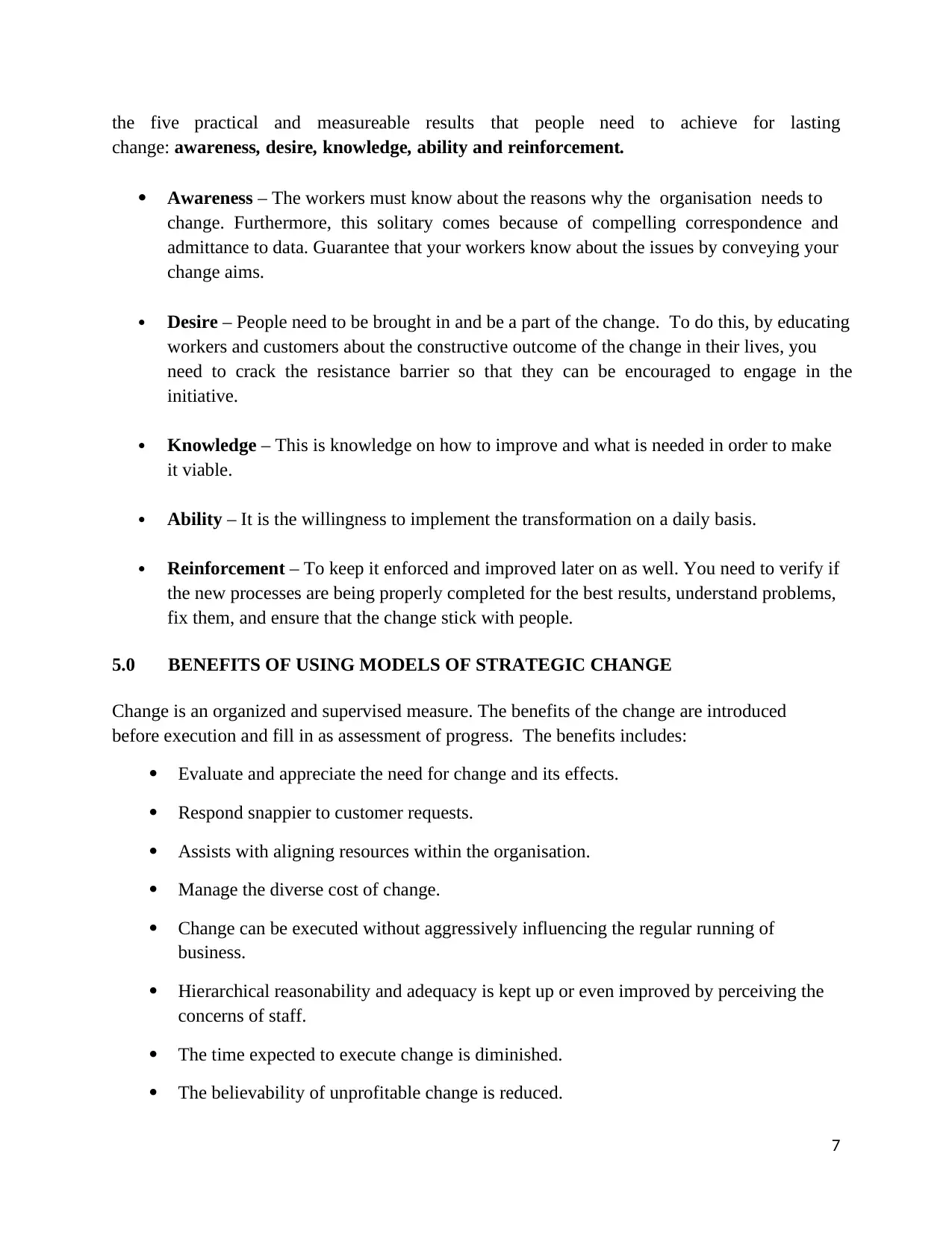
7
the five practical and measureable results that people need to achieve for lasting
change: awareness, desire, knowledge, ability and reinforcement.
Awareness – The workers must know about the reasons why the organisation needs to
change. Furthermore, this solitary comes because of compelling correspondence and
admittance to data. Guarantee that your workers know about the issues by conveying your
change aims.
Desire – People need to be brought in and be a part of the change. To do this, by educating
workers and customers about the constructive outcome of the change in their lives, you
need to crack the resistance barrier so that they can be encouraged to engage in the
initiative.
Knowledge – This is knowledge on how to improve and what is needed in order to make
it viable.
Ability – It is the willingness to implement the transformation on a daily basis.
Reinforcement – To keep it enforced and improved later on as well. You need to verify if
the new processes are being properly completed for the best results, understand problems,
fix them, and ensure that the change stick with people.
5.0 BENEFITS OF USING MODELS OF STRATEGIC CHANGE
Change is an organized and supervised measure. The benefits of the change are introduced
before execution and fill in as assessment of progress. The benefits includes:
Evaluate and appreciate the need for change and its effects.
Respond snappier to customer requests.
Assists with aligning resources within the organisation.
Manage the diverse cost of change.
Change can be executed without aggressively influencing the regular running of
business.
Hierarchical reasonability and adequacy is kept up or even improved by perceiving the
concerns of staff.
The time expected to execute change is diminished.
The believability of unprofitable change is reduced.
the five practical and measureable results that people need to achieve for lasting
change: awareness, desire, knowledge, ability and reinforcement.
Awareness – The workers must know about the reasons why the organisation needs to
change. Furthermore, this solitary comes because of compelling correspondence and
admittance to data. Guarantee that your workers know about the issues by conveying your
change aims.
Desire – People need to be brought in and be a part of the change. To do this, by educating
workers and customers about the constructive outcome of the change in their lives, you
need to crack the resistance barrier so that they can be encouraged to engage in the
initiative.
Knowledge – This is knowledge on how to improve and what is needed in order to make
it viable.
Ability – It is the willingness to implement the transformation on a daily basis.
Reinforcement – To keep it enforced and improved later on as well. You need to verify if
the new processes are being properly completed for the best results, understand problems,
fix them, and ensure that the change stick with people.
5.0 BENEFITS OF USING MODELS OF STRATEGIC CHANGE
Change is an organized and supervised measure. The benefits of the change are introduced
before execution and fill in as assessment of progress. The benefits includes:
Evaluate and appreciate the need for change and its effects.
Respond snappier to customer requests.
Assists with aligning resources within the organisation.
Manage the diverse cost of change.
Change can be executed without aggressively influencing the regular running of
business.
Hierarchical reasonability and adequacy is kept up or even improved by perceiving the
concerns of staff.
The time expected to execute change is diminished.
The believability of unprofitable change is reduced.
Paraphrase This Document
Need a fresh take? Get an instant paraphrase of this document with our AI Paraphraser
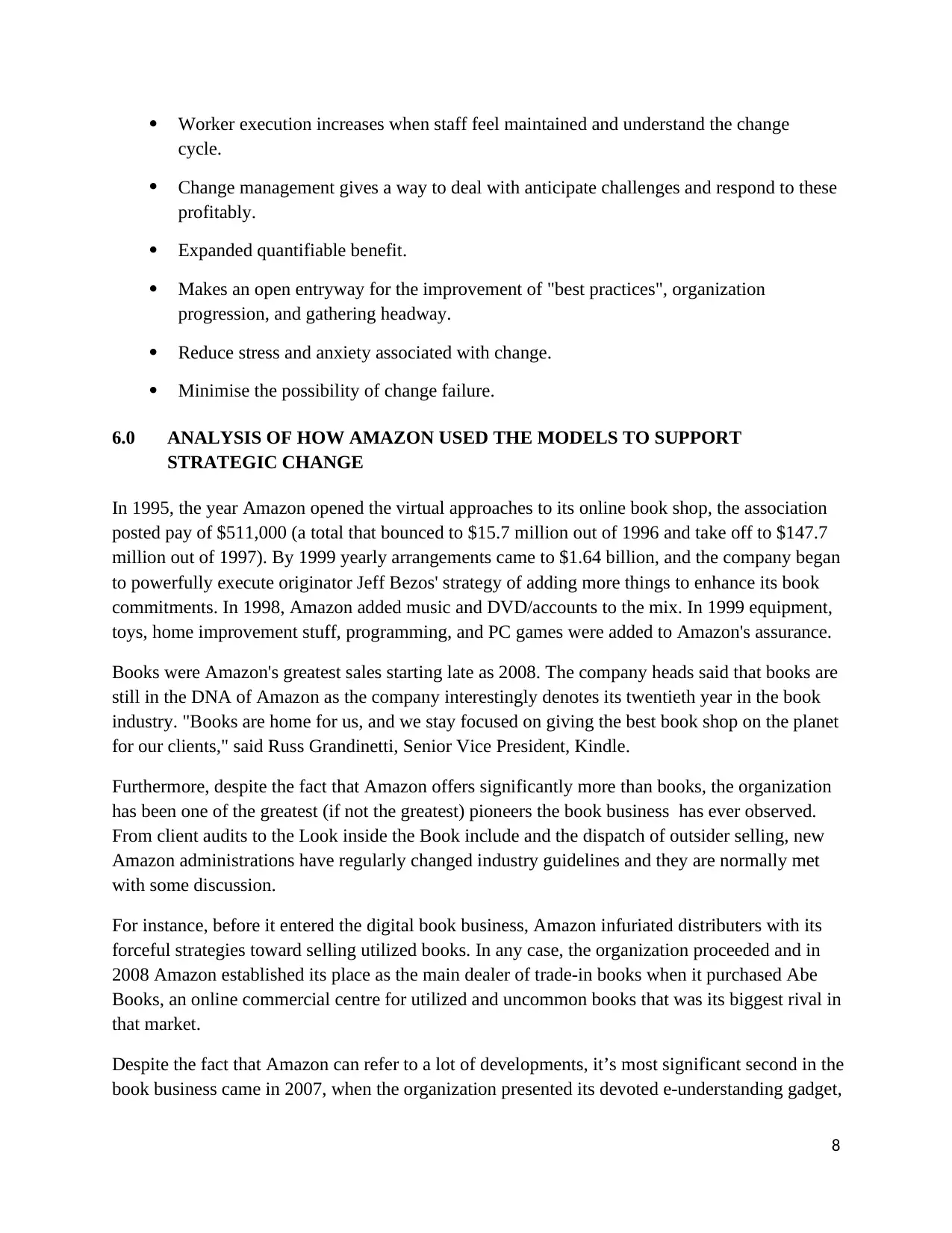
8
Worker execution increases when staff feel maintained and understand the change
cycle.
Change management gives a way to deal with anticipate challenges and respond to these
profitably.
Expanded quantifiable benefit.
Makes an open entryway for the improvement of "best practices", organization
progression, and gathering headway.
Reduce stress and anxiety associated with change.
Minimise the possibility of change failure.
6.0 ANALYSIS OF HOW AMAZON USED THE MODELS TO SUPPORT
STRATEGIC CHANGE
In 1995, the year Amazon opened the virtual approaches to its online book shop, the association
posted pay of $511,000 (a total that bounced to $15.7 million out of 1996 and take off to $147.7
million out of 1997). By 1999 yearly arrangements came to $1.64 billion, and the company began
to powerfully execute originator Jeff Bezos' strategy of adding more things to enhance its book
commitments. In 1998, Amazon added music and DVD/accounts to the mix. In 1999 equipment,
toys, home improvement stuff, programming, and PC games were added to Amazon's assurance.
Books were Amazon's greatest sales starting late as 2008. The company heads said that books are
still in the DNA of Amazon as the company interestingly denotes its twentieth year in the book
industry. "Books are home for us, and we stay focused on giving the best book shop on the planet
for our clients," said Russ Grandinetti, Senior Vice President, Kindle.
Furthermore, despite the fact that Amazon offers significantly more than books, the organization
has been one of the greatest (if not the greatest) pioneers the book business has ever observed.
From client audits to the Look inside the Book include and the dispatch of outsider selling, new
Amazon administrations have regularly changed industry guidelines and they are normally met
with some discussion.
For instance, before it entered the digital book business, Amazon infuriated distributers with its
forceful strategies toward selling utilized books. In any case, the organization proceeded and in
2008 Amazon established its place as the main dealer of trade-in books when it purchased Abe
Books, an online commercial centre for utilized and uncommon books that was its biggest rival in
that market.
Despite the fact that Amazon can refer to a lot of developments, it’s most significant second in the
book business came in 2007, when the organization presented its devoted e-understanding gadget,
Worker execution increases when staff feel maintained and understand the change
cycle.
Change management gives a way to deal with anticipate challenges and respond to these
profitably.
Expanded quantifiable benefit.
Makes an open entryway for the improvement of "best practices", organization
progression, and gathering headway.
Reduce stress and anxiety associated with change.
Minimise the possibility of change failure.
6.0 ANALYSIS OF HOW AMAZON USED THE MODELS TO SUPPORT
STRATEGIC CHANGE
In 1995, the year Amazon opened the virtual approaches to its online book shop, the association
posted pay of $511,000 (a total that bounced to $15.7 million out of 1996 and take off to $147.7
million out of 1997). By 1999 yearly arrangements came to $1.64 billion, and the company began
to powerfully execute originator Jeff Bezos' strategy of adding more things to enhance its book
commitments. In 1998, Amazon added music and DVD/accounts to the mix. In 1999 equipment,
toys, home improvement stuff, programming, and PC games were added to Amazon's assurance.
Books were Amazon's greatest sales starting late as 2008. The company heads said that books are
still in the DNA of Amazon as the company interestingly denotes its twentieth year in the book
industry. "Books are home for us, and we stay focused on giving the best book shop on the planet
for our clients," said Russ Grandinetti, Senior Vice President, Kindle.
Furthermore, despite the fact that Amazon offers significantly more than books, the organization
has been one of the greatest (if not the greatest) pioneers the book business has ever observed.
From client audits to the Look inside the Book include and the dispatch of outsider selling, new
Amazon administrations have regularly changed industry guidelines and they are normally met
with some discussion.
For instance, before it entered the digital book business, Amazon infuriated distributers with its
forceful strategies toward selling utilized books. In any case, the organization proceeded and in
2008 Amazon established its place as the main dealer of trade-in books when it purchased Abe
Books, an online commercial centre for utilized and uncommon books that was its biggest rival in
that market.
Despite the fact that Amazon can refer to a lot of developments, it’s most significant second in the
book business came in 2007, when the organization presented its devoted e-understanding gadget,
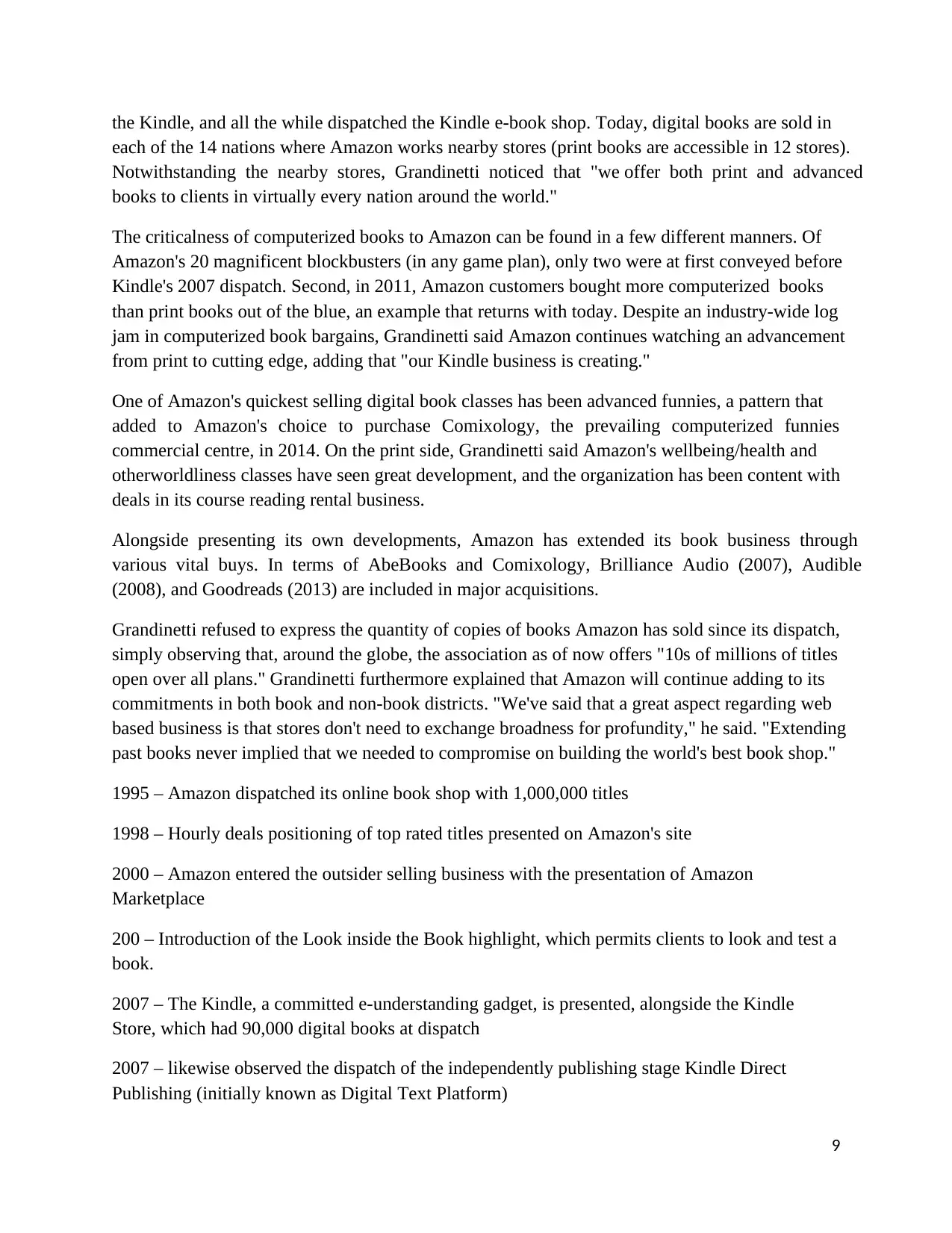
9
the Kindle, and all the while dispatched the Kindle e-book shop. Today, digital books are sold in
each of the 14 nations where Amazon works nearby stores (print books are accessible in 12 stores).
Notwithstanding the nearby stores, Grandinetti noticed that "we offer both print and advanced
books to clients in virtually every nation around the world."
The criticalness of computerized books to Amazon can be found in a few different manners. Of
Amazon's 20 magnificent blockbusters (in any game plan), only two were at first conveyed before
Kindle's 2007 dispatch. Second, in 2011, Amazon customers bought more computerized books
than print books out of the blue, an example that returns with today. Despite an industry-wide log
jam in computerized book bargains, Grandinetti said Amazon continues watching an advancement
from print to cutting edge, adding that "our Kindle business is creating."
One of Amazon's quickest selling digital book classes has been advanced funnies, a pattern that
added to Amazon's choice to purchase Comixology, the prevailing computerized funnies
commercial centre, in 2014. On the print side, Grandinetti said Amazon's wellbeing/health and
otherworldliness classes have seen great development, and the organization has been content with
deals in its course reading rental business.
Alongside presenting its own developments, Amazon has extended its book business through
various vital buys. In terms of AbeBooks and Comixology, Brilliance Audio (2007), Audible
(2008), and Goodreads (2013) are included in major acquisitions.
Grandinetti refused to express the quantity of copies of books Amazon has sold since its dispatch,
simply observing that, around the globe, the association as of now offers "10s of millions of titles
open over all plans." Grandinetti furthermore explained that Amazon will continue adding to its
commitments in both book and non-book districts. "We've said that a great aspect regarding web
based business is that stores don't need to exchange broadness for profundity," he said. "Extending
past books never implied that we needed to compromise on building the world's best book shop."
1995 – Amazon dispatched its online book shop with 1,000,000 titles
1998 – Hourly deals positioning of top rated titles presented on Amazon's site
2000 – Amazon entered the outsider selling business with the presentation of Amazon
Marketplace
200 – Introduction of the Look inside the Book highlight, which permits clients to look and test a
book.
2007 – The Kindle, a committed e-understanding gadget, is presented, alongside the Kindle
Store, which had 90,000 digital books at dispatch
2007 – likewise observed the dispatch of the independently publishing stage Kindle Direct
Publishing (initially known as Digital Text Platform)
the Kindle, and all the while dispatched the Kindle e-book shop. Today, digital books are sold in
each of the 14 nations where Amazon works nearby stores (print books are accessible in 12 stores).
Notwithstanding the nearby stores, Grandinetti noticed that "we offer both print and advanced
books to clients in virtually every nation around the world."
The criticalness of computerized books to Amazon can be found in a few different manners. Of
Amazon's 20 magnificent blockbusters (in any game plan), only two were at first conveyed before
Kindle's 2007 dispatch. Second, in 2011, Amazon customers bought more computerized books
than print books out of the blue, an example that returns with today. Despite an industry-wide log
jam in computerized book bargains, Grandinetti said Amazon continues watching an advancement
from print to cutting edge, adding that "our Kindle business is creating."
One of Amazon's quickest selling digital book classes has been advanced funnies, a pattern that
added to Amazon's choice to purchase Comixology, the prevailing computerized funnies
commercial centre, in 2014. On the print side, Grandinetti said Amazon's wellbeing/health and
otherworldliness classes have seen great development, and the organization has been content with
deals in its course reading rental business.
Alongside presenting its own developments, Amazon has extended its book business through
various vital buys. In terms of AbeBooks and Comixology, Brilliance Audio (2007), Audible
(2008), and Goodreads (2013) are included in major acquisitions.
Grandinetti refused to express the quantity of copies of books Amazon has sold since its dispatch,
simply observing that, around the globe, the association as of now offers "10s of millions of titles
open over all plans." Grandinetti furthermore explained that Amazon will continue adding to its
commitments in both book and non-book districts. "We've said that a great aspect regarding web
based business is that stores don't need to exchange broadness for profundity," he said. "Extending
past books never implied that we needed to compromise on building the world's best book shop."
1995 – Amazon dispatched its online book shop with 1,000,000 titles
1998 – Hourly deals positioning of top rated titles presented on Amazon's site
2000 – Amazon entered the outsider selling business with the presentation of Amazon
Marketplace
200 – Introduction of the Look inside the Book highlight, which permits clients to look and test a
book.
2007 – The Kindle, a committed e-understanding gadget, is presented, alongside the Kindle
Store, which had 90,000 digital books at dispatch
2007 – likewise observed the dispatch of the independently publishing stage Kindle Direct
Publishing (initially known as Digital Text Platform)
⊘ This is a preview!⊘
Do you want full access?
Subscribe today to unlock all pages.

Trusted by 1+ million students worldwide
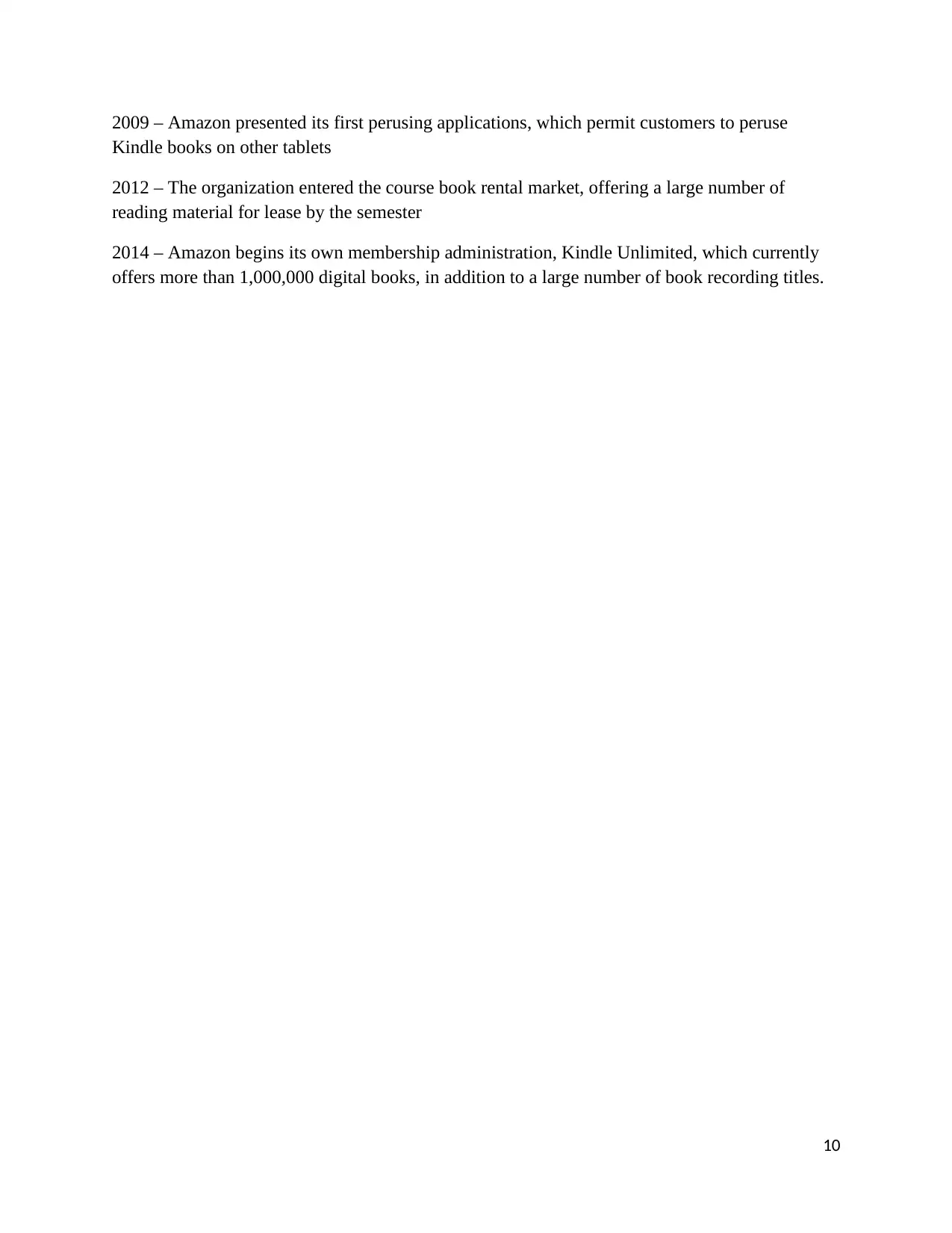
10
2009 – Amazon presented its first perusing applications, which permit customers to peruse
Kindle books on other tablets
2012 – The organization entered the course book rental market, offering a large number of
reading material for lease by the semester
2014 – Amazon begins its own membership administration, Kindle Unlimited, which currently
offers more than 1,000,000 digital books, in addition to a large number of book recording titles.
2009 – Amazon presented its first perusing applications, which permit customers to peruse
Kindle books on other tablets
2012 – The organization entered the course book rental market, offering a large number of
reading material for lease by the semester
2014 – Amazon begins its own membership administration, Kindle Unlimited, which currently
offers more than 1,000,000 digital books, in addition to a large number of book recording titles.
Paraphrase This Document
Need a fresh take? Get an instant paraphrase of this document with our AI Paraphraser
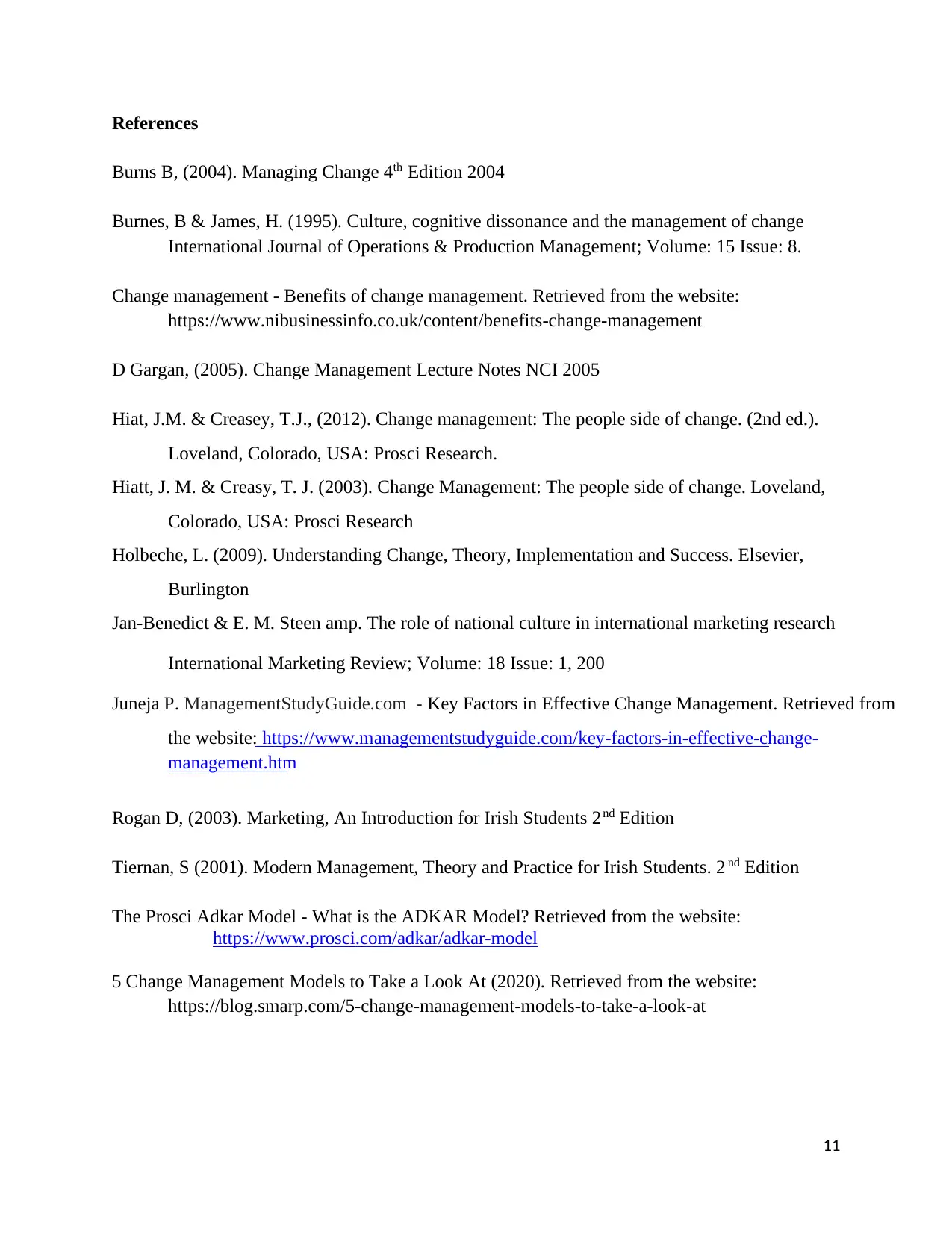
11
References
Burns B, (2004). Managing Change 4th Edition 2004
Burnes, B & James, H. (1995). Culture, cognitive dissonance and the management of change
International Journal of Operations & Production Management; Volume: 15 Issue: 8.
Change management - Benefits of change management. Retrieved from the website:
https://www.nibusinessinfo.co.uk/content/benefits-change-management
D Gargan, (2005). Change Management Lecture Notes NCI 2005
Hiat, J.M. & Creasey, T.J., (2012). Change management: The people side of change. (2nd ed.).
Loveland, Colorado, USA: Prosci Research.
Hiatt, J. M. & Creasy, T. J. (2003). Change Management: The people side of change. Loveland,
Colorado, USA: Prosci Research
Holbeche, L. (2009). Understanding Change, Theory, Implementation and Success. Elsevier,
Burlington
Jan-Benedict & E. M. Steen amp. The role of national culture in international marketing research
International Marketing Review; Volume: 18 Issue: 1, 200
Juneja P. ManagementStudyGuide.com - Key Factors in Effective Change Management. Retrieved from
the website: https://www.managementstudyguide.com/key-factors-in-effective-change-
management.htm
Rogan D, (2003). Marketing, An Introduction for Irish Students 2nd Edition
Tiernan, S (2001). Modern Management, Theory and Practice for Irish Students. 2 nd Edition
The Prosci Adkar Model - What is the ADKAR Model? Retrieved from the website:
https://www.prosci.com/adkar/adkar-model
5 Change Management Models to Take a Look At (2020). Retrieved from the website:
https://blog.smarp.com/5-change-management-models-to-take-a-look-at
References
Burns B, (2004). Managing Change 4th Edition 2004
Burnes, B & James, H. (1995). Culture, cognitive dissonance and the management of change
International Journal of Operations & Production Management; Volume: 15 Issue: 8.
Change management - Benefits of change management. Retrieved from the website:
https://www.nibusinessinfo.co.uk/content/benefits-change-management
D Gargan, (2005). Change Management Lecture Notes NCI 2005
Hiat, J.M. & Creasey, T.J., (2012). Change management: The people side of change. (2nd ed.).
Loveland, Colorado, USA: Prosci Research.
Hiatt, J. M. & Creasy, T. J. (2003). Change Management: The people side of change. Loveland,
Colorado, USA: Prosci Research
Holbeche, L. (2009). Understanding Change, Theory, Implementation and Success. Elsevier,
Burlington
Jan-Benedict & E. M. Steen amp. The role of national culture in international marketing research
International Marketing Review; Volume: 18 Issue: 1, 200
Juneja P. ManagementStudyGuide.com - Key Factors in Effective Change Management. Retrieved from
the website: https://www.managementstudyguide.com/key-factors-in-effective-change-
management.htm
Rogan D, (2003). Marketing, An Introduction for Irish Students 2nd Edition
Tiernan, S (2001). Modern Management, Theory and Practice for Irish Students. 2 nd Edition
The Prosci Adkar Model - What is the ADKAR Model? Retrieved from the website:
https://www.prosci.com/adkar/adkar-model
5 Change Management Models to Take a Look At (2020). Retrieved from the website:
https://blog.smarp.com/5-change-management-models-to-take-a-look-at
1 out of 11
Related Documents
Your All-in-One AI-Powered Toolkit for Academic Success.
+13062052269
info@desklib.com
Available 24*7 on WhatsApp / Email
![[object Object]](/_next/static/media/star-bottom.7253800d.svg)
Unlock your academic potential
Copyright © 2020–2025 A2Z Services. All Rights Reserved. Developed and managed by ZUCOL.


